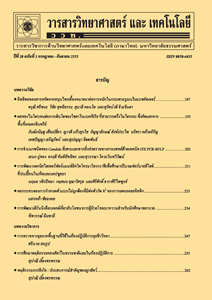การเปลี่ยนแปลงทางสัณฐานและสรีรวิทยาภายใต้สภาวะร่มเงาและตำแหน่งคู่ใบของใบกาแฟโรบัสต้า
Main Article Content
Abstract
Abstract
The vegetative growth of Robusta coffee plants in a mixed-fruit tree orchard is affected by multiple environmental factors. Moreover, it is directly dependent on the capacity to acclimatize to the abiotic stress conditions. This study was conducted to evaluate the effects of light conditions on the characteristics of the leaves of Robusta coffee plants, which were subjected to two different conditions of light. Sampling and measurements were collected in the youngest fully expanded leaves of lateral branches. Pairs of leaves were selected based on the leaf positions (1st, 3rd and 5th nodes). Results showed that Robusta coffee leaves from trees grown in the shade had lower values for specific leaf weight, stomata size, photosynthetic rate and water use efficiency (WUE) than leaves from trees grown in full-sun light. Moreover, there were significant differences between the leaf positions. Leaves that developed at the 3rd and 5th nodes were larger in structure (leaf area, specific leaf area and specific leaf weight) than leaves developed at the 1st node. Besides this, the highest stomatal size (stomatal length and stomatal width) and physiological responses (photosynthetic rate and WUE) were observed in the leaves exposed to full sun conditions with developed at the 3rd and 5th nodes. This study demonstrates that light conditions and leaf positions have a positive effect on the morpho-physiological characteristics of Robusta coffee leaves. As a result, these findings could be applied to a suitable habitat for canopy manipulation of Robusta coffee, especially in a mixed-fruit tree orchard grown in the region of southern Thailand.
Keywords: light intensity; physiological response; phenotypic adaptation; canopy manipulation; mixed orchard
Article Details
References
[2] กรมวิชาการเกษตร, 2560, กาแฟโรบัสต้าพันธุ์แนะนำของศูนย์วิจัยพืชสวนชุมพร, แหล่งที่มา : http://www.doa.go.th/hrc/chumphon/index.php, 10 เมษายน 2560.
[3] กรมวิชาการเกษตร, 2561, ยุทธศาสตร์กาแฟปี 2560-2564, แหล่งที่มา : http://www.doa.go.th/hort/images/jsn_is_thumbs/images/hort/strategiccoffee.pdf, 12 ธันวาคม 2560.
[4] พงศกร สุธีกาญจโนทัย, ระวี เจียรวิภา, บัญชา สมบูรณ์สุข และชนินทร์ ศิริขันตยกุล, 2560, ผลของการใส่ปุ๋ยเคมีร่วมกับปุ๋ยคอกต่อการเจริญเติบโตของต้นกาแฟโรบัสต้าในสวนยางพารา, ว.พืชศาสตร์สงขลานครินทร์ 4: 25-31.
[5] ระวี เจียรวิภา และชนินทร์ ศิริขันตยกุล, 2558, การปรับตัวลักษณะฟีโนไทป์ของต้นกาแฟโรบัสต้าภายใต้สวนไม้ผลผสมผสาน, ว. วิทย. กษ. 46: 433-436.
[6] สุรีรัตน์ ปัญญาโตนะ, ปานหทัย นพชินวงศ์, เสรี อยู่สถิต และยุพิน กสินเกษมพงษ์, 2555, การคัดเลือกพันธุ์กาแฟโรบัสต้าต่างประเทศ 12 สายต้น, น. 1-13, ใน งานวิจัยกาแฟโรบัสต้า เล่ม 1, ศูนย์วิจัยพืชสวนชุมพร, กรมวิชาการเกษตร, ชุมพร.
[7] Jaramillo-Botero, C., Santos, R.H.S., Martinez, H.E.P., Cecon, P.R. and Fardin, M.P., 2010, Production and vegetative growth of coffee trees under fertilization and shade levels, Sci. agric. (Piracicaba, Braz.) 67: 639-645.
[8] DaMatta, F.M., 2004, Ecophysiological, constraints on the production of shaded and unshaded coffee: a review, Field Crops Res. 86: 99-114.
[9] Morais, H., Medri, M.E., Marur, C.J., Caramori, P.H., Ribeiro, A.M.A. and Gomes, J.C., 2004, Modifications on leaf anatomy of Coffea arabica caused by shade of pigeonpea (Cajanus cajan), Braz. Arch. Biol. Technol. 47: 863-871.
[10] Franks, P.J., Drake, P.L. and Beerling, D.J., 2009, Plasticity in maximum stomatal conductance constrained by negative correlation between stomatal size and density: an analysis using Eucalyptus globulus, Plant Cell Environ. 32: 1737-1748.
[11] Restrepo-Díaz, H., Melgar, J.C. and Lombardini, L., 2010. Ecophysiology of horticultural crops: an overview, Agron. Colomb. 28: 71-79.
[12] Kufa, T. and Burkhardt, J., 2011, Stomatal characteristics in arabica coffee germplasm accessions under contrasting environments at Jimma, Southwestern Ethiopia, Int. J. Botany 7: 63-72.
[13] Sun, J.K., Li, T., Xia, J.B., Tian, J.Y., Lu, Z.H. and Wang, R.T. 2011. Influence of salt stress on ecophysiological parameters of Periploca sepium bunge, Plant Soil Environ. 57:139-144
[14] Guerra-Guimarães, L., Vieira, A., Chaves, I., Pinheiro, C., Queiroz, V., Renaut, J. and Ricardo, C.P., 2014, Effect of greenhouse conditions on the leaf apoplastic proteome of Coffea arabica plants, J. Proteomics 57: 1-12.
[15] Adds, J., Larkcom, E. and Miller, R.N., 1997, The Organism and the Environment (Nelson Advanced Modular Science, 2nd Ed.), Nelson Thornes, Ltd., Cheltenham.
[16] The Pennsylvania State University, 2009, Why do tree leaves have different shapes, Available Source: http://www.psu.edu/de pt/nkbiology/naturetrail/leaves.html, April 5, 2018.
[17] Lake, J.A., Woodward, F.I., and Quick, W.P., 2002, Long-distance CO2 signaling in plants, J. Exp. Bot. 53: 183-193.
[18] Pallardy, S.G. and Kozlowski, T.T., 1979, Frequency and length of stomata of 21 Populus clones, Can. J. Bot. 57: 2019-2523.
[19] Wang, S.G., Jia, S.S., Sun, D.Z., Wang, H.Y., Dong, F.F., Ma, H.X., Jing, R.L. and Ma, G., 2015, Genetic basis of traits related to stomatal conductance in wheat cultivars in response to drought stress, Photosynthetica 53: 299-305.
[20] Pompelli, M.F., Martins, S.C.V., Celin, E.F., Ventrella, M.C. and DaMatta, F.M., 2010, What is the influence of ordinary epidermal cells and stomata on the leaf plasticity of coffee plants grown under full-sun and shady conditions?, Braz. J. Biol. 70: 1083-1088.
[21] Elagoz, V., Hahn, S.S. and Manning, W.J., 2006, Acquired changes in stomatal characteristics in response to ozone during plant growth and leaf development of bush beans (Phaseolus vulgaris L.) indicate phenotypic plasticity, Environ. Pollut. 140: 395-405.
[22] Petrova, Y., 2012, The effect of light intensity on the stomatal density of lavender, Lavandula angustifolia, Young Sci. J. 12: 89-93.
[23] Adams, W.W.III., 1988, Photosynthetic Acclimation and Photoinhibition of Terrestrial and Epiphytic CAM Tissue Growing in Full Sunlight and Deep Shade, pp. 123-134, In Evans, J.R., Caemmerer, S. and Adams, W.W.III. (Eds.), Ecology of Photosynthesis in Sun and Shade, CSIRO Australia, Melbourne.
[24] Kumar, D. and Tieszen, L.L., 1980, Photosynthesis in Coffea arabica, I. effects of light and temperature, Expl. Agric. 16: 13-19.
[25] Koike, T., Kitao, M., Maruyama, Y., Mori, S. and Lei, T.T., 2000, Leaf morphology and photosynthetic adjustments among deciduous broad-leaved trees within the vertical canopy profile, Tree Physiol. 21: 951-958.
[26] Constable, G.A. and Ranson, H.M., 1980, Effect of leaf position, expansion and age on photosynthesis, transpiration and water use of cotton, Aust. J. Plant Physiol. 7: 89-100.
[27] Araus, J.L., Amaro, T., Zuhair, Y. and Nachit, M.M., 1997, Effect of leaf structure and water status on carbon isotope discrimination in field-grown durum wheat, Plant Cell Environ. 20: 1484-1494.


